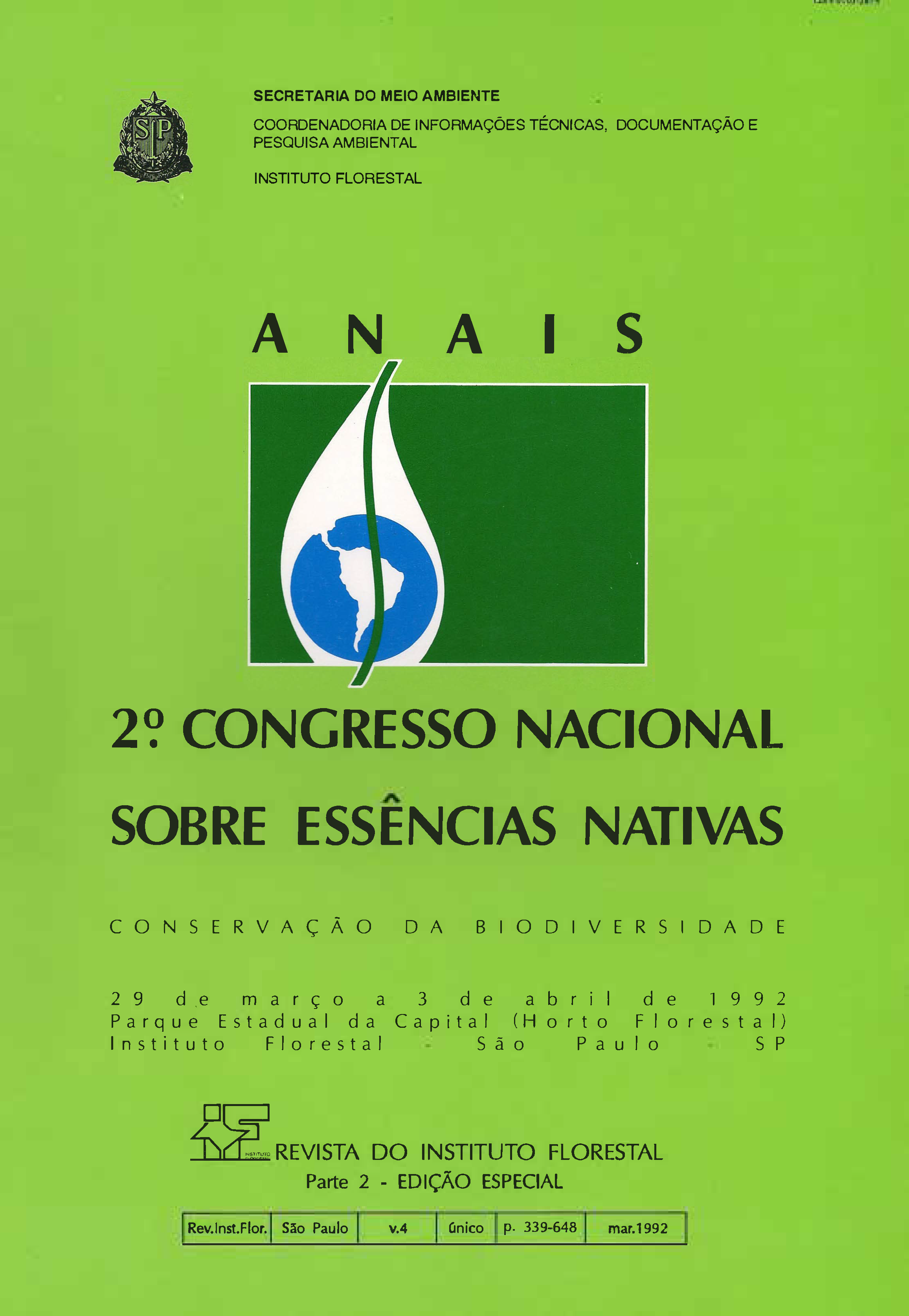GRUPOS ECOLÓGICOS E A DISPERSÃO DE SEMENTES DE ESPÉCIES ARBÓREAS EM TRECHO DA FLORESTA TROPICAL NA RESERVA FLORESTAL DE LINHARES (ES)
DOI:
https://doi.org/10.24278/2178-5031.199241343Keywords:
ecological group, tropical forest, syndrome of dispersion, sucessionAbstract
ln the present study, the different ecological groups and predominant process of dispersion in woody species of a tropical forest (Forest Reserve-Unhares, ES) were analysed. Of 227 species studied, 57% corresponds to secondary species, 23% to pioneers and 20% to tolerant. Syndrome of zoochory dispersion was observed in 74% of lhe species, anemochory was observed in 24% of the species and autochory was observed in 4% of the species. The authors concluded that the process of sucession in tropical forests depends on lhe actions of biotic dispersion.
Downloads
References
BAZZAZ, F. A. & PICKETT, S. T. A., 1980. Phsyiological ecology of tropical sucessíon: A comparativa review. Ann. Rev. of Eco/. and Syst. , 11 : 287-31Op.
BUDOWSKI, G. 1963. Forest succession in tropical lowland. Turrialba, 13 (1 ): 43-44p.
BUDOWSKI, G. 1965. Distribution on tropical american rain forest species in the light of sucessional processes. Turrialba, 15 (1): 40-42p.
CHARLES-DOMINIQUE, P. 1986. lnter-relations between frugivorous vertebrates and pioneer plants: Cecropia, birds and bats in French Guyana. IN: A. Estrada and T. H. Fleming (eds.) Frugivores and seed dispersai. The Netherlands, Dordrecht, Dr. W. Junk Publishers, 119-135p.
DENSLOW, J. S. 1980. Gap partitioning among tropical rain forest trees. Biotropica, 12 (supl.): 47-55p.
GANDOLFI, S. 1991. Estudo florístico e fitossociológico de um floresta residual na área do Aeroporto Interna cional de São Paulo, Município de Guarulhos, SP. Campinas, SP (Dissertação mestrado-1B/UNICAMP), 232p.
GUEVARA, S. and GOMEZ-POMPA, A. 1972. Seeds from suriace soils in a tropical region of Vera Cruz, Mexico. J.Arnold Arbor., 53: 12-335p.
HARPER, J. L.1977. Population biology of plants. Academic Pres, New York.892p.
HARTSHORN, G. S. 1980. Neotropical forest dynamics. Biotropica, 12 (supl.): 23-30p.
INOUE, M. T.; RODERJAN, C. V. & KUNIYOSHI, Y. S. 1984. Projeto Madeira doParaná. Curitiba, Fundação de Pesquisas Florestais do Paraná, 260p.
LONGMAN, K. A. & JENIK, J. 1974. Tropical forest and its environment. London, Longman, 196p.
MARTINEZ-RAMOS, M. 1985. Claros, ciclos vitales de los arboles tropicales y regeneración natural de las selvas altas perenifolias. lN: A. Gomez - Pompa & S. Dei Amo R. (eds.). lnvestigaciones sobre la regeneración de selvas altas em Vera Cruz, Mexico. Tomo 11, 313-332p.
MARTINEZ-RAMOS, M.; ALVAREZ-BUYLLA, E. &SARUKHAN, J. 1989. Tree demography and gap dynamics in a tropical rain forest. Ecology, 70 (3): 555-558p.
MATTHES, L. A. F. 1980. Composição florística, estrutura e fenologia de uma floresta residual do planalto paulista: Bosque dos Jequitibás. Campinas, (Dissertação mestrado - IB/UNICAMP), 209p.
MURRAY, K. G. 1988. Avian seed dispersai of three neotropical gap dependent plants. Ecological Monographs, 58(4): 271-298p.
PEIXOTO, A. L. & GENTRY; A. 1990. Diversidade e composição florística da mata de tabuleiro na Reserva Florestal de Unhares (ES). Rev. Brasil Bot. , 13(1): 19-25p.
PIO CORRÊA, M. 1926. Dicionário das plantas úteis do Brasil e das exóticas cultivadas. Ministério da Agricultura, Serviço de Informação Agrícola, 6 vol.
REITZ, R.; KLEIN, R. M. & REIS, A. 1978. Projeto Madeira de Santa Catarina. ltajaí, SC, Herbário Barbosa Rodrigues, 320p.
ROSSI, L., 1987. A flora arbórea-arbustiva da mata de Reserva da Cidade Universitária "Armando de Salles Oliveira". São Paulo, (Dissertação mestrado - IB/USP) 270p.SALIS, S. M. de. 1990. Composição florística e estrutura de um remanescente de mata ciliar do Rio Jacaré Pepira, Brotas (SP). Campinas, (Dissertação mestrado - IB/UNICAMP), 111p.
SCHUPP, E. W.; HOWE, H. F.; AUGSPURGER, C. K. and LEVEY, D. J. 1989. Arrival and survival in tropical treefall gaps. Ecology 70 (3): 562-564p.
SWAINE, M. D. & WHITMORE, T. C. 1988. On the definition of ecological species groups in tropical rain forests. Vegetation, 75: 81-86p.
VAN DER PIJL, L. 1972. Principies ofdispersal in higher plants: Berlin, Springer Verlag, 162p.
WHITMORE, T. C. 1989. Canopy gaps andthe two major groups of forest trees. Ecology, 70 (3): 536-538p.















